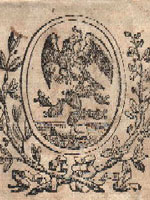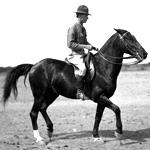The Wilmot Proviso
This iCue Mini-Documentary introduces David Wilmot, a Democratic Representative from Pennsylvania, who, in 1848, insisted that slavery be banned in any new states acquired from Mexico.
This feature is no longer available.
This iCue Mini-Documentary introduces David Wilmot, a Democratic Representative from Pennsylvania, who, in 1848, insisted that slavery be banned in any new states acquired from Mexico.
This feature is no longer available.
A new interactive online exhibit from the California Council for the Humanities (CCH)—"We Are California"—will explore the history and stories of those who have immigrated or migrated to California. A new partnership between the Council and the California History-Social Science Project (CHSSP) will help to bring this exciting resource to the classroom. The topic of these workshops will be "The Era of Great Internal Migrations to California" between World War I and World War II. It will discuss, contrast, and analyze the experiences of Dust Bowl migrants to California, Mexicans, and Mexican Americans.
This iCue Mini-Documentary describes how temporary workers from Mexico filled huge labor shortages created by World War II and became part of the continuing debate about immigration.
This feature is no longer available.
Near this area, a wooden picket fort was constructed around 1831 by Mexican forces in anticipation of trouble with Anglo immigrants. The fort apparently was named for a camp of Lipan Apaches in the vicinity. In 1835, the small guard force that held the fort surrendered it to Texan forces without a shot being fired. In 1842, a battalion of Texas volunteers camped in this area. In an attempt to lay claim to the territory between the Nueces River and the Rio Grande, the camp was seized by Mexican general Antonio Canales, but the Mexican forces later retreated. Around 10 years later, during the Mexican War, troops under General Zachary Taylor passed through this area on their way to the Rio Grande.
The site is open to the public.
Website does not specify any interpretive services available at the site.
Fannin Battleground State Historic Site encompasses more than 13 acres. On March 20, 1836, at this site, Colonel J. W. Fannin and 284 of his men surrendered after the Battle of Coleto to Mexican General Jose Urrea and were told they would be treated as prisoners of war. Seven days after the capture, General Santa Anna had Fannin and the men with him, plus other prisoners captured in the area, executed as traitors. Twenty-eight prisoners escaped but 342 men were massacred near what is now Goliad State Park.
The site is open to the public.
Website does not specify any interpretive services offered at the site.
This iCue Mini-Documentary describes how the discovery of gold in California in 1848 led to an unprecedented migration, as thousands of people traveled west in the hopes of making it big.
This feature is no longer available.
At this workshop participants will engage in dynamic, in-depth, interdisciplinary study of the Alamo and associated major themes of American history, literature, and popular culture. They will study in intimate seminar settings with major scholars, interact with their colleagues in lively conversations, and develop classroom teaching activities based on individual interdisciplinary research conducted in the Alamo Library Archives, the Institute of Texans Cultures, the American History Center and other Texas archives while working in seminars with five nationally recognized Texas scholars.

The Peace Corps has a three-fold mission. First and foremost, the organization sends volunteers to communities around the world which have requested assistance in creating sustainable solutions to real world problems. Second (and third, really), is an interest in increasing international understanding and friendship—of non-Americans for Americans and vice versa.
One of the most exciting options the Peace Corps offers educators is the World Wise Schools Correspondence Match program. The program permits educators to request a pen pal relationship with a Peace Corps volunteer in a region of the world and area of interest (agriculture, business, education, health, or environment) of their choosing. Maybe your students could discuss the lasting impact of the Vietnam War with a volunteer in Southeast Asia or how U.S. business history has altered life in China or Central America. This could also be an excellent way to introduce social studies students to the connection between history and geography and fields more often taught at the collegiate level, such as anthropology and international relations.
Another feature offered is a collection of more than 120 lesson plans. These are not focused on history per se, but you may be able to find a lesson which will strengthen themes you are pursuing in the classroom. One such lesson involves planning a service learning project. Oral histories are a classic way to combine service learning and history.

Facsimiles and transcriptions of 12 Texas Constitutions from 1824 to 1876. Constitutions include the 1824 Federal Constitution of United Mexican States, in Spanish with an English transcription; the document that joined Texas to the U.S. in 1845; the 1861 secession constitution; and the 1869 reconstruction version. Visitors may search all constitutions by subject. The site provides annotated bibliographies of 61 primary source documents and 55 books and articles about Texas constitutions. Links to 13 sites about Texas history and constitutions in general. The site is easy to navigate and will be interesting for research on legal history and the west.

These more than 8,000 images document the history and development of South Texas and the border. The collection features the life's work of commercial photographer Robert Runyon (18811968). Topics include the U.S. military presence in the area prior to and during World War I and the growth and development of the Rio Grande Valley in the early 1900s.
A special section presents nine of Runyon's 350 photographs of the Mexican Revolution (19101920) in Matamoros, Monterrey, Ciudad Victoria, and the Texas border area from 1913 through 1916. "Maps of the Lower Rio Grande" offers a number of topographical and military maps depicting the region. The website also offers essays on the revolution and on Runyon.